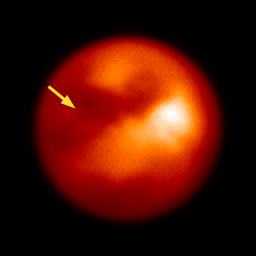UC Berkeley Press Release
Keck telescope captures Titan but misses Huygens
|
BERKELEY – Despite real though faint hopes, ground-based astronomers failed to see any sign of the Huygens probe's plunge into Titan's atmosphere today (Friday, Jan. 14), but they did obtain some near-infrared images of Saturn's largest moon at the moment of impact.
The images were captured by the world's largest telescope, the 10-meter Keck telescope seated atop Mauna Kea in Hawaii. The bright and dark patches on the surface were the only detail visible of the surface, with most features obscured by the moon's dense hydrocarbon haze.
"We did observe, as through a miracle we opened up (the telescope dome) in 40 to 50 mile-per-hour winds," said Imke de Pater, professor of astronomy at the University of California, Berkeley. " We didn't see anything, but just got context images - the only ones taken, I believe - during probe entry."
De Pater was one of a team of astronomers training the Keck telescope on Titan just after midnight in Hawaii to view Huygens pierce the atmosphere to start its two and a half hour descent to the surface.
Near-infrared images were taken from the W. M. Keck Observatory with the near infrared camera (NIRC2) and the adaptive optics system at the time of probe entry. The team had planned imaging sequences to look for thermal emissions or condensates at the probe entry site.
The probe, launched late last year by the Cassini mother ship, did send back photos from 10 miles above the surface that showed channels running through hilly terrain. And it apparently survived a landing, at least long enough to send back signals from the surface.
Titan is of particular interest to scientists because it is the only moon in our solar system with a dense, methane-rich, nitrogen atmosphere, reminiscent of our own atmosphere here on Earth. The moon is cloaked in a thick, smog-like haze produced by the breakup of methane by sunlight. Further study of this moon could provide clues to planetary formation and evolution and, perhaps, about the early days of Earth as well.
"Although no disturbances in Titan's atmosphere were detected, the observations provide the best images that characterize the satellite at the moment of probe entry," said Antonin Bouchez, a staff member at the Keck observatory who was leading the observing effort.
"It was worth getting up in the middle of the night for this historic moment," said Fred Chaffee, director of the Keck Observatory, "despite the bad weather on the mountain".
Winds were blowing at 40-50 m.p.h., while the mountaintop itself was still cloaked with snow and ice from a recent storm.
Other team members that participated in the observations were David LeMignant from the Keck Observatory and Michael Brown, a professor at Caltech.
For more on Keck observations of Titan before the arrival of Cassini and Huygens, see the story at https://newsarchive.berkeley.edu/news/media/releases/2004/10/13_Huygens.shtml.
Links:


